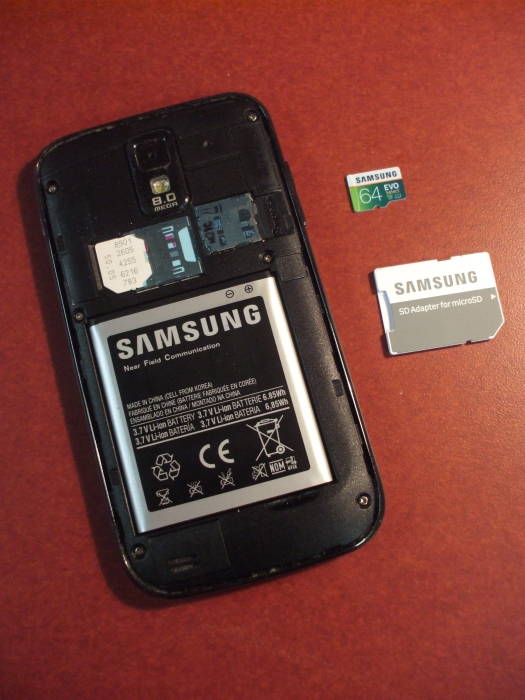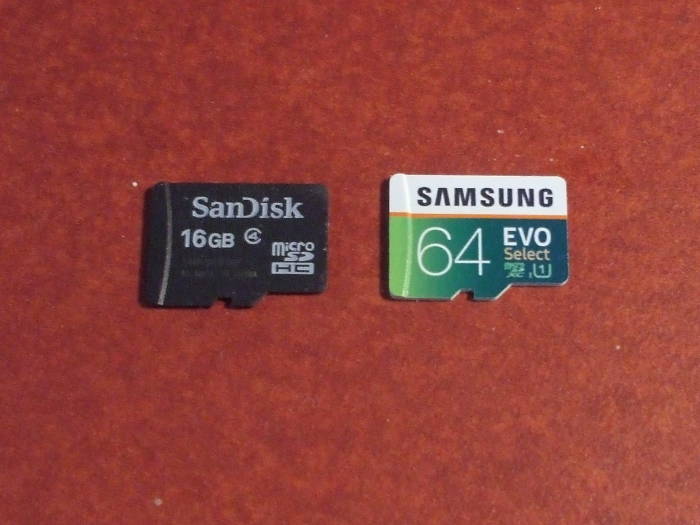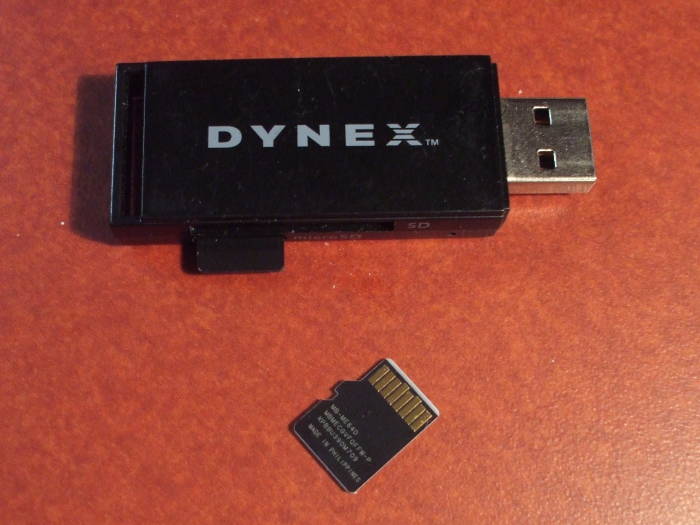
How to Upgrade Smart Phone Memory with Linux Utilities
Upgrading Flash Memory Chips
We want to install a larger flash memory chip in an
Android smart phone.
We need to make sure that all of the data has been
transferred.
This must include all of our personal data — pictures,
music, and other media — plus the data structures
used by our apps.
The tar utility in Linux makes this easy.

I originally added a 16 GB memory chip in the phone. Now I wanted to upgrade to 64 GB.


Plug the memory chip into a reader, and then
plug the reader into a USB port on your computer.
Below is what we find in the kernel ring buffer on Linux.
I have several fixed disks in this system,
sda through sdf,
so this new device becomes sdg.
$ dmesg
[... many lines deleted ...]
[40643.503784] usb 2-1: new high-speed USB device number 3 using xhci_hcd
[40643.687226] usb 2-1: New USB device found, idVendor=05e3, idProduct=0723
[40643.687229] usb 2-1: New USB device strings: Mfr=3, Product=4, SerialNumber=2
[40643.687230] usb 2-1: Product: USB Storage
[40643.687231] usb 2-1: Manufacturer: Generic
[40643.687231] usb 2-1: SerialNumber: 000000009451
[40643.689039] usb-storage 2-1:1.0: USB Mass Storage device detected
[40643.692802] usb-storage 2-1:1.0: Quirks match for vid 05e3 pid 0723: 8000
[40643.696786] scsi host9: usb-storage 2-1:1.0
[40644.747626] scsi 9:0:0:0: Direct-Access Generic STORAGE DEVICE 9451 PQ: 0 ANSI: 0
[40644.945620] sd 9:0:0:0: [sdg] 31116288 512-byte logical blocks: (15.9 GB/14.8 GiB)
[40644.946657] sd 9:0:0:0: [sdg] Write Protect is off
[40644.946659] sd 9:0:0:0: [sdg] Mode Sense: 03 00 00 00
[40644.947590] sd 9:0:0:0: [sdg] No Caching mode page found
[40644.947594] sd 9:0:0:0: [sdg] Assuming drive cache: write through
[40644.961245] sdg: sdg1
[40644.965507] sd 9:0:0:0: [sdg] Attached SCSI removable disk
[40723.791333] usb 2-1: USB disconnect, device number 3
[40733.941295] usb 2-1: new high-speed USB device number 4 using xhci_hcd
[40734.122805] usb 2-1: New USB device found, idVendor=05e3, idProduct=0723
[40734.122808] usb 2-1: New USB device strings: Mfr=3, Product=4, SerialNumber=2
[40734.122809] usb 2-1: Product: USB Storage
[40734.122810] usb 2-1: Manufacturer: Generic
[40734.122811] usb 2-1: SerialNumber: 000000009451
[40734.124990] usb-storage 2-1:1.0: USB Mass Storage device detected
[40734.134314] usb-storage 2-1:1.0: Quirks match for vid 05e3 pid 0723: 8000
[40734.139308] scsi host9: usb-storage 2-1:1.0
[40735.181143] scsi 9:0:0:0: Direct-Access Generic STORAGE DEVICE 9451 PQ: 0 ANSI: 0
[40735.379108] sd 9:0:0:0: [sdg] 31116288 512-byte logical blocks: (15.9 GB/14.8 GiB)
[40735.380235] sd 9:0:0:0: [sdg] Write Protect is off
[40735.380238] sd 9:0:0:0: [sdg] Mode Sense: 03 00 00 00
[40735.381293] sd 9:0:0:0: [sdg] No Caching mode page found
[40735.381297] sd 9:0:0:0: [sdg] Assuming drive cache: write through
[40735.395823] sdg: sdg1
[40735.400704] sd 9:0:0:0: [sdg] Attached SCSI removable disk
[40737.576590] FAT-fs (sdg1): Volume was not properly unmounted. Some data may be corrupt. Please run fsck.
I could have done this on OpenBSD.
The only difference is that the device names are different.
Let's say it's on my laptop, which has just one
fixed disk, sd0.
The new USB device would be sd1,
and /dev/sd1i would be the relevant slice
and device name to use in the following.
Back on my Linux desktop, the KDE graphical environment has
mounted the new device under /run/media.
The automatically generated mount point within that is
the user name and then the volume ID of the file system.
$ df -hT Filesystem Type Size Used Avail Use% Mounted on devtmpfs devtmpfs 3.9G 0 3.9G 0% /dev tmpfs tmpfs 3.9G 377M 3.5G 10% /dev/shm tmpfs tmpfs 3.9G 18M 3.9G 1% /run /dev/sde3 btrfs 111G 33G 76G 31% / tmpfs tmpfs 3.9G 0 3.9G 0% /sys/fs/cgroup tmpfs tmpfs 3.9G 75M 3.8G 2% /tmp /dev/sde2 xfs 1.1G 289M 751M 28% /boot /dev/sde1 vfat 499M 132K 498M 1% /boot/EFI /dev/sda1 ext4 917G 563G 354G 62% /home2 /dev/sdb1 xfs 930G 458G 472G 50% /home3 /dev/sdd1 xfs 3.7T 2.1T 1.7T 56% /home /dev/sdc1 ext4 1.8T 1.6T 243G 87% /home4 tmpfs tmpfs 791M 12K 791M 1% /run/user/1000 /dev/sdg1 vfat 15G 1.7G 14G 11% /run/media/cromwell/6139-3733
I change to the newly mounted file system to see what's there.
$ cd /run/media/cromwell/6139-3733/ $ ls -lah total 182M drwx------ 9 cromwell cromwell 32K Dec 31 1969 . drwxr-x---+ 3 root root 60 Apr 8 21:24 .. drwx------ 2 cromwell cromwell 32K Dec 6 2014 .android_secure drwx------ 3 cromwell cromwell 32K Dec 6 2014 Android drwx------ 4 cromwell cromwell 32K Mar 11 2014 DCIM drwx------ 2 cromwell cromwell 32K Mar 2 16:27 LOST.DIR -rw-r--r-- 1 cromwell cromwell 20M Jun 28 2013 SGH-T989_UVMC6_radio.zip drwx------ 2 cromwell cromwell 32K May 11 2016 System Volume Information drwx------ 3 cromwell cromwell 32K Dec 31 2011 clockworkmod -rw-r--r-- 1 cromwell cromwell 11M Jan 10 2013 cwm6012touch_v12.5_hercules.zip -rw-r--r-- 1 cromwell cromwell 151M Dec 6 2014 gapps-kk-20140606-signed.zip drwx------ 4 cromwell cromwell 32K Jan 10 2013 media
Now I make an archive in my home directory.
The archive is of the current directory, ".", and therefore
all the contents of this file system.
If you simply copy or archive the contents while referring
to them as "*", that will not match those with names
starting with "." such as .android_secure
in this example.
$ tar cf ~/phone.tar . $ cd $ ls -lh phone.tar -rw-rw-r-- 1 cromwell cromwell 1.7G Apr 8 21:26 phone.tar
Now swap the memory chips. The new one may have an exFAT file system. The FAT32 file system cannot have files larger than 4 GB.
Note that FAT32 or exFAT is the file system, thus the total volume size, number of files, and maximum file size. VFAT has to do with supporting long file names.
If a file system is FAT32 it probably includes the VFAT extension, but VFAT might be used with FAT12 or FAT16.
You will need the exFAT tools to support exFAT. On Linux the packages are probably exfat-utils and fuse-exfat, on OpenBSD it is the single package exfat-fuse.
| Type | Max volume size | Max file size | Max number of files |
| FAT12 | 32 MiB | volume size | 4,096 |
| FAT16 | 2 GiB | volume size | 65,536 |
| FAT32 | 16 GiB | 4 GiB | 268,173,300 |
| exFAT | 128 PiB | 128 PiB | 2,796,202 per directory |
# rpm -ql exfat-utils fuse-exfat | grep bin /usr/sbin/dumpexfat /usr/sbin/exfatfsck /usr/sbin/exfatlabel /usr/sbin/fsck.exfat /usr/sbin/mkexfatfs /usr/sbin/mkfs.exfat /usr/sbin/mount.exfat /usr/sbin/mount.exfat-fuse
With those tools in place, the system can mount the device. The new mount point will be an essentially random file system volume ID.
# file -s /dev/sdg /dev/sdg: DOS/MBR boot sector # file -s /dev/sdg1 /dev/sdg1: DOS/MBR boot sector # fdisk -l /dev/sdg Disk /dev/sdg: 59.7 GiB, 64087916544 bytes, 125171712 sectors Units: sectors of 1 * 512 = 512 bytes Sector size (logical/physical): 512 bytes / 512 bytes I/O size (minimum/optimal): 512 bytes / 512 bytes Disklabel type: dos Disk identifier: 0x00000000 Device Boot Start End Sectors Size Id Type /dev/sdg1 32768 125171711 125138944 59.7G 7 HPFS/NTFS/exFAT # df -hT /run/media/cromwell/FC54-7B8F Filesystem Type Size Used Avail Use% Mounted on /dev/sdg1 fuseblk 60G 2.7M 60G 1% /run/media/cromwell/FC54-7B8F
Now I can extract the archive into the empty file system on the new memory chip.
$ cd /run/media/cromwell/FC54-7B8F
$ tar xvf ~/phone.tar
[... many lines deleted ...]
$ df -hT .
Filesystem Type Size Used Avail Use% Mounted on
/dev/sdg1 vfat 60G 1.7G 59G 3% /run/media/cromwell/FC54-7B8F
Almost 60 GB of free space for pictures and other media!